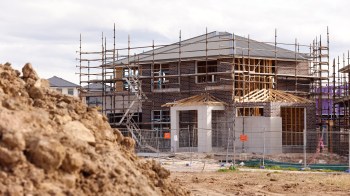Housing construction up in November
Share Now on:
Housing construction up in November
Kai Ryssdal: From the Commerce Department this morning came these glad tidings: Construction of new homes and permits for new projects rose last month. The highest they’ve been in 18 months.
In particular, developers went crazy building multi-family homes. Apartment buildings and the like. There’s a growing niche market, in fact, of more people from the same family deciding to live under the same roof.
Sarah Gardner reports from the Marketplace Sustainability Desk.
Sarah Gardner: Chino, Calif.: 40 miles east of L.A. To many Angelenos, it’s a faceless exurb filled with cookie-cutter homes and smelly dairy farms. But to others, it’s big houses on big lots at reasonable prices.
And Greg McGuff, a division president at Lennar Homes, is itching to sell some freshly built houses here.
Greg McGuff: Craftsman, Tuscan, Prairie-style architecture. You see a lot of rock and a lot of stone and exposed timber and beam.
Never mind the timber and beam. What’s novel about this development are four models Lennar is testing out called “NextGen” homes. As in, generations living together under one roof.
McGuff: Either the boomerang kids coming back to live with their parents, or the parents living with their parents or the sandwich generation where you have the children, the parents and the grandparents all living in one location.
Nearly 20 percent of Americans now live like that. This “doubled up” phenomenon accelerated during the recession. And it’s prompted builders like Lennar to go beyond the timeworn casita or finished basement. Lennar’s design in Chino is a 3,300 square foot home; 600 of that is a semi-private “suite” with its own entrance. Boomerangs and grandparents, step right in.
McGuff: The reservation you have of ‘oh, I’m coming home and my mother-in-law’s on my couch.’ That isn’t the case. Your mother-in-law’s on her own couch.
So, family togetherness, with an out. That’s what Edward, a 33-year-old Chino resident was thinking when he bought one of these houses. We bumped into him right afterward.
Edward: It’s something that I’ve never seen before. Y’know, we like it.
Edward says yes, he wants to live with his in-laws. In fact, he and his wife asked them to move in with them, partly so they can pool their resources in a bad economy.
Edward: You share the costs, and the help we have with the kids and building the relationships that are really, I think, important in life.
Lennar is testing these multi-generational homes in Arizona, California and Nevada. Notably, in cities with a lot of Asian and Hispanic immigrants, who are more apt to live with grandparents. But sales associate Gail Stricklin says she talked to potential buyers who want the space for unemployed relatives and boomerang kids as well. Or, in one couple’s case, for the husband.
Gail Stricklin: He was like oh my gosh, this is perfect. And he’s truly going to use that space just to have his own man-cave.
Other builders are testing out their own versions of multi-generational housing. They see it as a niche market that could kick start sales in an anemic economy.
Real estate consultant Patrick Duffy.
Patrick Duffy: About 20 percent of builders think it’s the greatest thing ever. They want to jump right on it. You have another 20 percent of builders say it’ll never happen. And the rest are sort of wait and see. And this tends to be a wait-and-see industry.
Gary Painter, director of USC’s Lusk Center for Real Estate, isn’t convinced builders will find much of a market for these kind of homes beyond Asians and Latinos — especially once the economy recovers.
Gary Painter: The research suggests that these young adults, once they find jobs, once they feel secure about the jobs they have will likely go back to sort of normal living arrangements.
But Lennar’s Greg McDuff says that still leaves the waves of retiring baby boomers. As they live longer and medical and assisted living costs rise, family togetherness, he argues, may begin to sound not sentimental, but economical.
In Chino, Calif., I’m Sarah Gardner for Marketplace.
There’s a lot happening in the world. Through it all, Marketplace is here for you.
You rely on Marketplace to break down the world’s events and tell you how it affects you in a fact-based, approachable way. We rely on your financial support to keep making that possible.
Your donation today powers the independent journalism that you rely on. For just $5/month, you can help sustain Marketplace so we can keep reporting on the things that matter to you.


















